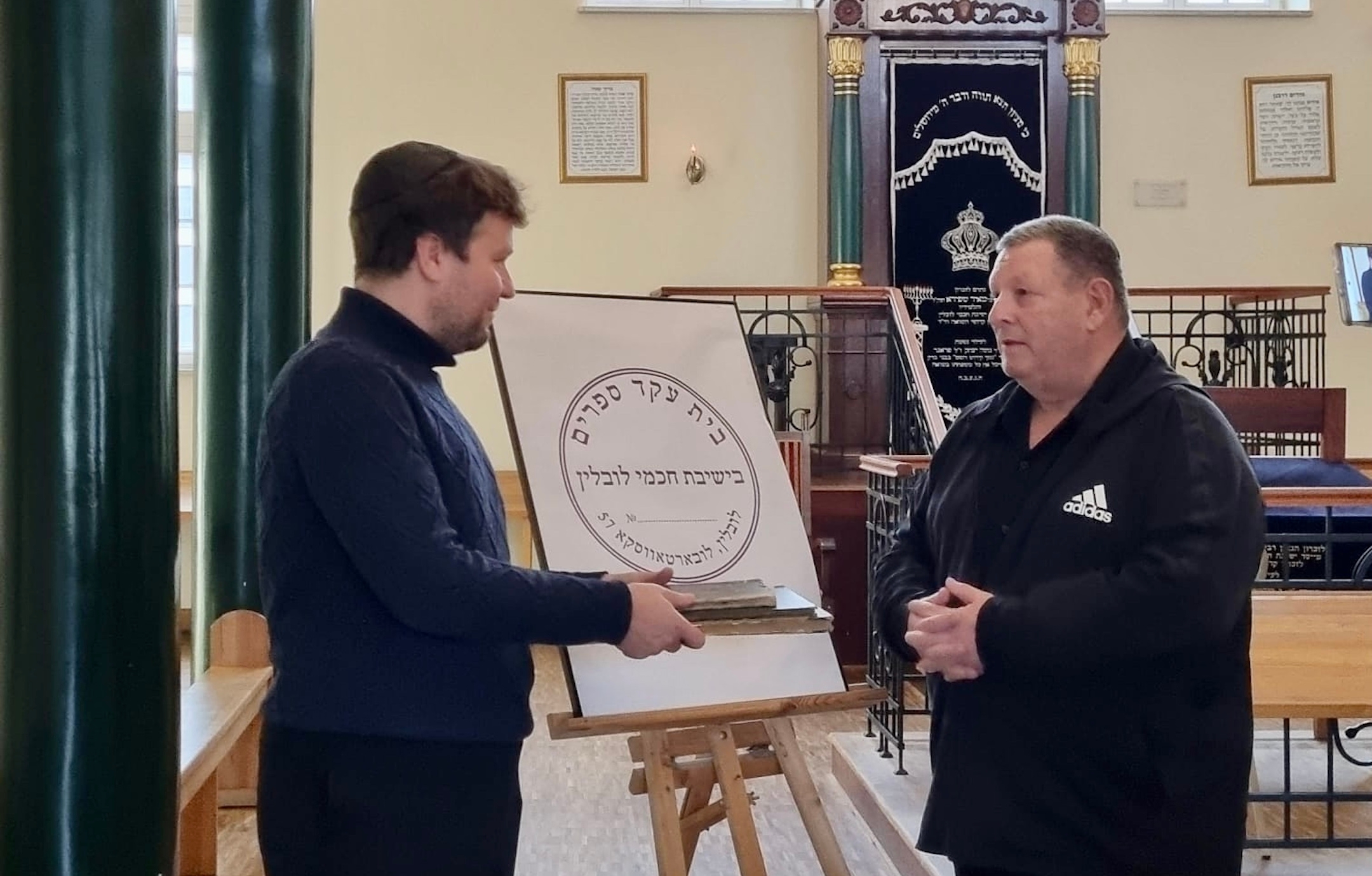(JTA) — For decades after World War II, a famed Jewish house of study in Poland was consigned to oblivion.
The Nazis set fire to thousands of books stored at the Chachmei Lublin Yeshiva in 1939, the popular story went, leaving no trace of its enormous library even as its students were sent to their deaths.
But while Lublin’s Jews were murdered, that great bonfire never occurred, according to Lublin local Piotr Nazaruk, who researches the city’s Jewish history at the Grodzka Gate-NN Theater Center. Nazaruk was fascinated by a set of mysteries cloaking the Lublin Yeshiva, once among the largest Jewish educational institutions in the world, whose yellow building still stands in the former Jewish quarter — now mostly empty of Jews.
“We’ve all seen images of books being burned by the Nazis during the war,” Nazaruk told the Jewish Telegraphic Agency. “But if this yeshiva and its library were so famous, and it was such a prestigious thing for the Nazis to destroy it, why are there no traces — no photos or documents — actually proving that it happened?” And if there were no fire, might those books still be available today, in attics, private collections and on the shelves of people unaware of their tragic provenance?
There are about 40 Jews in Lublin today, but over 40,000 lived there before the Holocaust, roughly one third of the city’s population. Nazaruk, who is not Jewish, became fascinated with Poland’s Jewish history over 10 years ago. He happened upon a series of Yiddish newspapers at a library in his hometown of Biała Podlaska, north of Lublin. The discovery inspired him to study Yiddish.
“For me, this Jewish, Yiddish-speaking world of prewar Poland is almost like a parallel universe,” he said. “It happened in places that I know, on streets I walk. It was like discovering a hidden history of places I know very well.”
Nazaruk threw himself into investigating the disappearance of the Lublin Yeshiva Library. He had on his side other skeptics of the bonfire story, including Adam Kopciowski, a Lublin historian at the Maria Curie-Skłodowska University who found five of the yeshiva’s books at the former Chevra Nosim synagogue — Lublin’s only surviving prewar synagogue — in the early 2000s.
Nazaruk found press reports, dated after Lublin’s liberation by the Russian army in 1944, that indicated the library had survived. Then, one slow afternoon at work, he was scrolling through the digital archive of the Jewish Historical Institute in Warsaw and came across a treasure trove: 130 books with Lublin Yeshiva stamps.

Piotr Nazaruk (left) and Meir Bulka in the Lublin Yeshiva on Dec. 20, when Bulka entrusted Nazaruk with three books bearing Lublin Yeshiva Library stamps that he acquired in Israel. The poster shows a facsimile of the stamps. (Courtesy Nazaruk)
That discovery began a quest to reunite the books that once belonged to the Jewish library, estimated to hold between 15,000 and 40,000 volumes at the dawn of World War II. Nazaruk now feels sure that most of the historic collection was not burned, but instead scattered across the globe.
Over the past three years, he has amassed a digital catalog of 850 books with stamps identifying their roots at the Lublin Yeshiva Library. The vast majority of these cannot be physically returned to Lublin, since they are now the property of public and private collections worldwide — from Warsaw and Jerusalem to New York, Prague and elsewhere.
Only 10 of the lost volumes have made their way home. In addition to the five found by Kopciowski, two were returned by Berlin’s Freie Universität in 2022, and three more found by an Israeli who personally delivered them to Lublin in December.
Together with Lublin’s small remaining Jewish community, Nazaruk is planning a public display for these 10 books in the former yeshiva building.
His project belongs to a recent trend of “memory activism” in Poland, according to Geneviève Zubrzycki, a sociologist who researches nationalism and religion at the University of Michigan. Education about the mass murder of Polish Jews did not start until the 1980s, when the Soviet Union fell and Poland began a process of democratization. Even then, silence about the past prevailed for decades in many small towns of Galicia once filled with Jews.
“Ninety percent of Polish Jewry was exterminated, and those who survived very often decided not to return to Poland,” Zubrzycki told JTA. “So if you have few Jews left in Poland to talk about their experience, and you have a large Polish population who remembers their [own] suffering — and that suffering is also folded into a socialist narrative that’s imposed by the Soviets — it leaves very little for Jewish memory-making.”
Although some books on the Lublin Yeshiva Library’s shelves dated back to the 16th century, the yeshiva itself lived less than 10 years.
The school opened in 1930 under the leadership of Rabbi Meir Shapiro, who planned a new kind of yeshiva to raise the prestige of the Torah student. His goal was not only to offer the highest caliber of religious education, but also to house students in a modern institution with respectable dormitories and lecture halls, showers, good meals and an infirmary.
“Before Lublin, boys in yeshivas usually lived in very poor conditions, they ate poorly,” said Nazaruk. “Being a yeshiva student was not like being in some prestigious university.”
With the help of donations from Jewish communities across Poland and abroad, Shapiro rapidly built one of the largest Jewish libraries in Poland. A New York rabbi, Benjamin Gut of the Chasam Sopher synagogue, sent an estimated 4,000 books and $1,000 to Lublin. After Shapiro died in 1933, the library also absorbed his own private book collection.
Lublin was a vital center of Jewish culture in Poland and home to a significant share of Jews since the early 1600s. Under the Nazis, the city became a center of mass extermination and its Jewish population was obliterated. About 5,000 Jews settled there after the Holocaust, but most left in the late 1940s, after local Poles killed Holocaust survivors in the Kielce Pogrom of 1946 and antisemitism in the Soviet Union convinced many there was no future for Jews in Poland.
In the war’s aftermath, a widespread story about a Nazi bonfire emerged to explain the disappearance of the Lublin Yeshiva Library . This account, cited by researchers and historians over the years, has been traced to a note reportedly published in a Nazi youth magazine titled “Die Deutsche Jugend-Zeitung.”
The newspaper allegedly boasted that the library’s books were devoured by a fire lasting 24 hours, while a Nazi band played military music to “cover the cries of the Jews.” But no one has ever seen that magazine in person, according to Nazaruk. The first reference to it appears in Hatsofe, a newspaper in British-mandate Palestine, in 1941.
The spectacle of book burnings was typically photographed, filmed and used to supply propaganda for Nazi newsreels. But if a Lublin Yeshiva Library fire was indeed reported in a “Die Deutsche Jugend-Zeitung,” it was never corroborated by any other Nazi newspapers or German authorities.
Nazaruk said it’s unclear how the rumor started. But it is known that the Germans tasked Rabbi Aron Lebwohl, a yeshiva graduate, with cataloging the library — an indication that they did not plan to destroy it. Lebwohl worked on this inventory until he was murdered at Majdanek in 1942.
Several Nazi organizations were interested in cataloging and looting Jewish collections for their own purposes, according to Daniel Lipson, a librarian at the National Library of Israel.
“Many were interested in antisemitic scholarship — starting to study the Jewish people that no longer existed, as they hoped would happen,” Lipson told JTA.
Nazaruk reasons that the yeshiva’s collection was carefully stored and prepared for transport to Germany. When the Russians marched into Lublin and the Germans fled, he believes, the books were abandoned.

The Chachmei Lublin Yeshiva was dedicated on June 24, 1930. A decade later, it would be defunct at the hands of the Nazis. (Courtesy Grodzka Gate-NN Theater Center)
How the books were dispersed through the world is a question that Nazaruk is still piecing together. Kopciowski has theorized that many were destined for Prague, where the Germans were amassing a collection of artifacts looted from Jewish communities across Europe. Lublin books may also have been pillaged by the Russian army, which took as many as 2 million books — including Jewish books and manuscripts — to the Soviet Union, according to journalist Anders Rydell.
Nazaruk has ascertained that over 100 Lublin Yeshiva books were shipped to Warsaw, where the Jewish Historical Institute was established in 1947 and where he first uncovered a collection of volumes with yeshiva stamps.
Another 100 have been identified at the National Library of Israel. At the end of the war, the Hebrew University in Jerusalem sent scholars to trace famous archives of Jewish books in Europe and bring them to Israel. The Central Committee of Polish Jews handed about 85,000 books to the Hebrew University, including an uncertain number from the Lublin Yeshiva Library, Lipson said.
Many of the Lublin Yeshiva books that arrived in Israel are likely still undocumented. The Hebrew University kept some books from Poland at the National Library of Israel but distributed the rest to smaller libraries, schools and synagogues across the country.
Nazaruk expects that much of the library’s collection has ended up in private hands. He frequently sees Lublin Yeshiva books crop up in online auctions, fetching prices from $200 to $11,000 — far out of budget for his research project.
He believes that his digitally reconstituted library of 850 books is just the tip of the iceberg.
“A few years ago, most people thought that the entire collection was destroyed,” he said. “Eight hundred books is maybe 5% of the original holdings — so on the one hand it’s not a lot, but on the other hand, it proves that probably thousands more are still around.”
Nazaruk’s scavenging resembles other efforts to revive Jewish history across Poland. Since the early 2000s, about 40 festivals of Jewish culture have been instituted in cities and towns across the country, many of them organized by non-Jews. According to Zubrzycki, this revival points to a nostalgia among some Polish groups for a past in which Jews are a symbol — in a country where Jews as a living people are sparse.
“Many [of those leading the revival] are practicing Catholics, but they want to recover this kind of pluralism that no longer exists in Poland,” said Zubrzycki. She noted that Poland is about 95% ethnically Polish today, one of the most homogeneous states in the world. “They feel that recovering the Jewish history of Poland is a way to build multiculturalism.”






